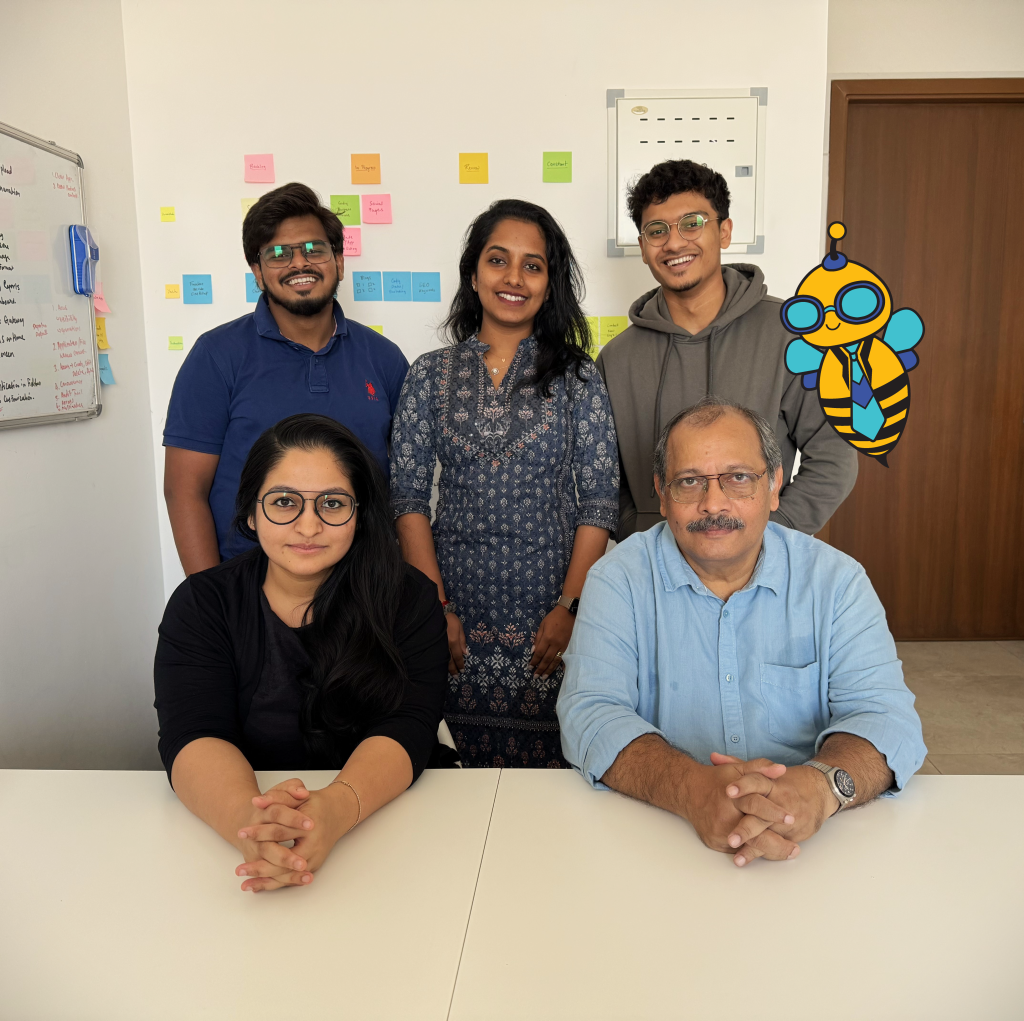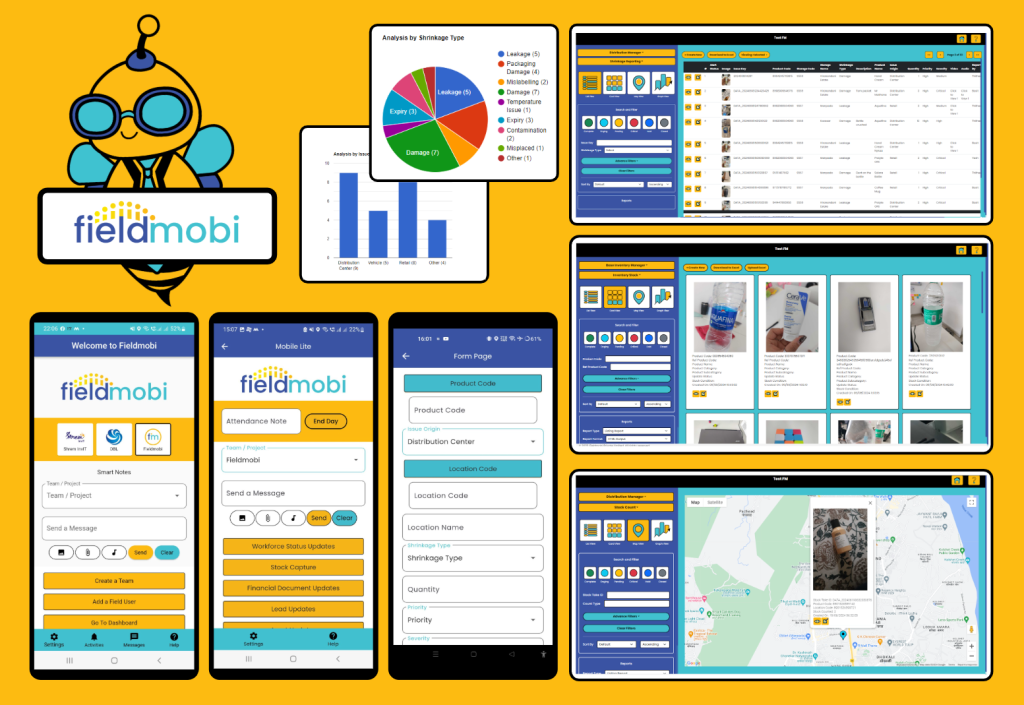ERP has long been a system built for back offices, not frontline teams. Fieldmobi is flipping that script with a mobile-first, AI-powered approach that makes ERP faster to deploy and easier to use. Co-founder Shambhabi Raha shares how they’re tackling the industry’s biggest barriers—long implementation times, steep learning curves, and rigid pricing—while bringing enterprise-level tools to businesses of all sizes.
1. What inspired the creation of Fieldmobi, and how has its vision evolved since its inception?
Shambhabi Raha: Today, Fieldmobi is focused on mobile-first, customizable ERP, which can be rolled out in minutes, but when we started, our goal was to extend the capabilities of ERP to field teams and frontline operations. In many senses, our goals haven’t really changed. We continue to focus on bringing ERP to the 99%, only now we do so both in terms of the scale and types of the organization using it and in terms of the teams and individuals within these organizations actually connecting to it. Somewhere along the way, we realized that we had to build an ERP system to connect to an ERP system anyway and ERP had left far too large a gap due to its inaccessible nature to ignore.
We have had ambitious plans from the start, but we built in phases. If you look at one of our plans from the absolute beginning, it actually looked more like what we have now than most of the plans in the middle. We wanted to build a no-code application generator with in-built ERP intelligence and a mobile application that is so simple that education and training play no part in whether or not a person can use it. But it would have been impossible to build it all at once.
For some context, we are a Father-Daughter team. Shiv Shankar (my dad and CTO) has been in the ERP/enterprise tech space for well over 3 decades. He has been in senior positions at companies like Peoplesoft (now Oracle) as well as ventured out on his own, having built and sold ERP systems in the past. He has been obsessed with creating a platform that can manage the major complexities of an ERP system without needing massive person-hours of work. Those decades of experience helped put the backend engine together quite quickly and our next focus was on building a mobile app that didn’t just replicate the web platform but allowed field and frontline workers (with limited technology skills) to capture data and manage activities. We set up a partnership for the road maintenance industry very early on. This helped us get some early revenue, but more importantly, it put the app in the hands of contractors and workers whose primary job is to fill potholes and cracks, helping us ensure that absolutely anyone could use it.
From there, we went on to launch three times on Product Hunt. We started with a single application that would allow field users to capture and share geotagged messages with images, audio notes and attachments, and they’d automatically get categorized and structured. We made it to the top five products of the day and got a lot of insight, but we knew that we had to do more. This is part of our solution offering now as Messages in Workforce Management.
From there, we learned that our mobile app was great, but our dashboard needed a lot of work. We rebuilt the dashboard with an all-new UI and decided to launch the Workforce Management application first. We made it to the top products of the day (and week this time), but we learned that people were treating the system more as a simple field team management system and that it wasn’t nearly as highly prioritized as an ERP system.
We regrouped and set out to build up the rest of the applications but knew that for this to work, we needed to change how ERP was implemented radically. With our team growing, things started taking shape faster and we launched fieldmobi.ai with Fieldmo the Bee as the face of it to help users customize their applications instantly through a simple chat interface. Once again we made it to the top products. This time we even made it to the top products of the month for SaaS.
We are now getting ready to come out of beta with the launch of the Fieldmobi ERP Starter Pack and hope that it’s going to make ERP accessible to ambitious businesses of any size.

Shambhabi Raha (CEO) and Shiv Shankar Raha (CTO) with the Fieldmobi team.
2. What are the main barriers Fieldmobi is addressing in digitizing the 99%, and how are these being overcome?
Shambhabi Raha: ERP is a complex system that usually comes with a great deal of setup and planning. No two organizations manage their businesses the same which means customization is a requirement. Traditional ERP systems take somewhere between 6 to 18 months to roll out, with skilled consultants charging by the hour for hundreds of hours. This in itself makes ERP inaccessible to any business that isn’t a large enterprise. When you put that together with the large amount of training required to use it, the cost of licenses, and the rigidity of the systems, they make them nearly impossible to roll out.
Then, if you look at who uses an ERP system, even within a large enterprise, it’s really just a back office team. If management wants a report, they ask that the team extract the data, put it together in an Excel sheet and make it look good before sending it over days later. When it comes to getting frontline users onboard, there is no way that they would be able to use it. Even systems that claim they have a mobile app have a replica of the dashboard in mobile form. It’s too much work trying to find the module that needs to be filled, let alone filling it all up in the middle of a busy workday.
ERP systems have hardly changed in the last 30 years and most players were designed for an era where most people were uncomfortable with technology because you really did need to be certified to use an app 30 years ago. You don’t anymore. The era has changed, but the systems haven’t. It is only a matter of time before someone (hopefully us) destroys the notion that ERP is only for large enterprise back offices and extends its usage to businesses of all sizes and teams of all functions.
3. Fieldmobi integrates with diverse enterprise workflows. Could you elaborate on how this seamless integration benefits users?
Shambhabi Raha: Our applications are modular so that users can roll them out one at a time, but they are entirely connected in terms of structure. So, with every additional module, you have more functionality that is built in. It wouldn’t be fair to call that integration because, in reality, the entire thing is a single platform that is so flexible that everything from inventory to accounting can be managed on it, and the platform can be easily customized for specific workflows. There is the option of connecting to other systems, too, of course, through API or doing bulk uploads and downloads to manage bulk data.

4. Your focus on mobile-first design stands out. How does this approach improve adoption and usability for frontline teams?
Shambhabi Raha: One of the biggest issues that most ERP systems have when it comes to their Android/iOS apps is that they are usually just replicas of their dashboards. There is just too much on it. It’s hard to find things, and you need training to use it. There is so much functionality within ERP that it’s next to impossible to make that simple, no matter how much you spend on making it look good. It has to be approached entirely differently to work.
From day one, we were clear that the roles of the mobile app and the dashboard were different. We wanted the mobile app to be designed specifically for field and floor users, the people who were on the frontlines, doing real blue-collar work. They didn’t need to access a complicated dashboard with lots of data. They didn’t need to access all the modules in their organization. They just needed to see what they needed to use. That’s how our app works. If you look at any one user’s app, it seems like there is almost nothing to it. If your role is to manage stock, that’s all you’ll see. If it’s to install and remove assets in the field, you know the work assigned to you, and you can scan the asset and share an update. Organizations and modules are assigned to a phone number, and those modules show up and nothing else. Every time data is shared, it comes with a timestamp, it is geotagged, and it can include media like images, audio and video.
The mobile app is not only an activity and team management tool but also a data collection tool, giving users access to data with proof of authenticity.
Then, we take all of that and put it into the web dashboard. This is where the functionality shines. It is designed for CXOs, managers, and team leads to analyze the data coming in. This includes a comprehensive search and filter feature, graphical analytics, data on a GIS map, summaries and reports, etc. We’ve made sure that this is also mobile-friendly because no one should have to wait to get access to important information, but its purpose is entirely different.
5. Data security is critical for enterprise adoption. How does Fieldmobi ensure compliance and protect user data?
Shambhabi Raha: From the day we started we were sure that we would put in measures to make sure that access to user data is fully controlled. We have a comprehensive set of access and visibility controls to ensure restrictions. The system is structured so that enterprise users can even host their data on their cloud servers. We would have no access to it at all unless specifically granted. The app can connect to multiple servers at the same time, so this is not a problem. Because this is such a priority to us, we even made sure that our AI customizer runs on an entirely different server so it can generate the application configurations without having any access to proprietary data.
Sensitive personal data is stored on secured servers with SSL certificates issued by leading certificate authorities and encrypted when transferred. We follow the international standards under IS/ISO/ IEC 27001 to provide reasonable security.
6. Fieldmobi emphasizes modular ERP solutions. Could you provide examples of how these modules have transformed operations for your clients?
Shambhabi Raha: Each module brings with it a different kind of value, solving a different problem for our clients. But that is true for any ERP system. What really sets us apart is how far and how easily we can customize the module for the specific client’s use case.
Take the Road Maintenance application, for example. That is a customization on various Field Operations modules. Our clients use it to manage and monitor the status of defects on National Highways. As you can imagine, highways are spread out and tough to manage, and unchecked defects can lead to significant fines and penalties for concessionaires. Using our applications, each highway is mapped out, and defects are logged using the Android/iOS app but inspectors. This is then assigned to external contractors who update the status of work using the app as well. Supervisors review the work and share a similar update. Everything comes with location, images and timestamps so the central team can remotely keep track of it all. Not only does this reduce fines and penalties, but it also reduces the number of trips the central teams need to take to projects drastically.
7. How do you foresee ERP technology evolving by 2025, and what role will Fieldmobi play in shaping these changes?
Shambhabi Raha: It is a very interesting time for ERP. For the first time in its history, all the major players have announced a sunset date for legacy ERP support. This is massive because companies like SAP, Oracle and Microsoft are forcing their customers to migrate their systems. Because ERP is basically the heart of most enterprise tech stacks, this means that there are thousands of large enterprises fully rethinking their entire stack and looking to solve a lot of the problems that became abundantly clear while using these legacy systems. This is a big opportunity for Fieldmobi, but there is a bigger one that is a consequence of this. Because of the sheer number of companies that need to migrate now, there is a huge shortage of ERP consultants that is not likely to reduce anytime in the near future. This means that businesses that are looking to roll out ERP for the first time will find themselves with very few options to do so. We believe Fieldmobi’s AI-customizer and instant rollout is going to be a gamechanger here. Fieldmo the Bee (our AI bot) can fully customize applications, adding fields, altering options and even translating the applications (mobile and dashboard) to different languages in an instant.
8. Fieldmobi offers flexible pricing and modularity. How do these factors make the platform competitive in a crowded ERP market?
Shambhabi Raha: A major differentiating factor for us is how we’re structured and how we price the product. In terms of structure, we essentially have two tracks—one for business owners and one for department heads of larger organizations.
For Business Owners, we have an ERP Starter Pack with a set of applications that they can customize and roll out instantly themselves. As they grow, we have an À La Carte menu of applications that they can add on.
For Department Heads, we provide a set of solutions to solve very specific problems in the form of Bento Boxes. We are in the process of getting our first Bento Box ready for IoT and Telecom Device Management. They can add to it through our Made-to-order offering where we set up fully custom applications to fill in gaps.
In terms of pricing, what makes us unique is not only the fact that we reduce the one-time setup costs very significantly, if not completely (for online applications), but we have role-based licenses instead of one-size-fits-all. What this means is that we charge significantly less for a Field User or Operator than an Admin or Manager so that organizations are incentivized to connect their entire team. The base application price comes with a set of users included. For example, the ERP Starter Pack contains 1 Admin User, 10 Dashboard Viewers (CXO Users), 1 Dashboard User (Manager or Team Lead), 5 Full Mobile Users (Supervisors, Field Users and Operators) and 50 Limited Mobile Users (End Users). Beyond this, role-based licenses can be added.
9. What do you enjoy most and least about your journey in developing Fieldmobi?
Shambhabi Raha: One of the nicest parts about what we do is watching someone try the application for the first time. Most people start off very underconfident about being able to prepare the application themselves, and they are so pleasantly surprised when they see how easy it is to customize and set up. But aside from that, we really like watching the system evolve and grow.
The most challenging part is sometimes delays. Things don’t always happen as quickly as you hope, and no matter how much you do, it’s never quick enough. Starting out, you’re working with limited resources, so a random bug can throw off your schedule by days. It’s a lot of prioritizing, and that means giving up some things that you would really like to do to do things that you really need to do.
10. What was the biggest challenge your team faced, and how did you overcome it?
Shambhabi Raha: The biggest challenge we faced was when we launched Fieldmobi Frontline (the workforce management application). We built it to be an ERP feeder application, but we very quickly realized that people were relegating it to a simple task tracker/field service management application.
We realized that we would have to rethink our strategy and pivot so that the system’s value could be showcased. That’s when we started working on the fieldmobi.ai platform, and in hindsight, I’m happy it happened.
11. What does success mean to you, and what are your aspirations for Fieldmobi in the coming years?
Shambhabi Raha: The ultimate goal is to cause a significant change in the ERP industry. We want to change how it works fundamentally. We want to make ERP (the system that is meant to make businesses efficient) efficient when it comes to rolling out and we want it to reach everyone from management to the field team to customers and vendors. We actually built a community layer into the framework, too, that we hope we can launch when the time comes. The idea is that there is a certain set of data that you may want to share with your partners to make things even more transparent and efficient. A large enterprise might want all of its vendors to share supply forecasts or track stock among resellers. We have enough ideas to take this well into a decade.
12. What does a typical day look like for your team at Fieldmobi?
Shambhabi Raha: Everyone in a startup will say the same thing, but every day is different. We usually work in two shifts, really—one at the office and one at home. The office is usually more sales/execution oriented. There is a lot of application development, sales calls, content creation, testing, and that sort of stuff. Our team (we call them the Founding Force) takes care of a lot of things. The home part is mainly between the founders (my dad and I). It’s a lot of strategy and product/solution design and things like that in terms of discussions, but we also spend a lot of time finishing up the work we need to do ourselves. We work pretty late into the night usually and are back up by 7 am the next morning.
Editor’s Note
Talking to Shambhabi Raha, it’s clear Fieldmobi isn’t just tweaking ERP—it’s rethinking it from the ground up. She’s not interested in making incremental improvements to an old model. Instead, she’s focused on breaking down the barriers that have kept ERP out of reach for so many businesses. The father-daughter founding story adds another layer to this: decades of enterprise tech experience combined with a fresh, no-nonsense approach to usability. Fieldmobi isn’t just about software; it’s about making sure businesses, from the field to the boardroom, can actually use it.
You can browse all our AI founder interviews. Looking for upcoming AI conferences? Visit our AI Events Calendar.
Explore more AI founder stories
- Abhay Gupta on AI Grading That Understands Math with Frizzle | Interview
- Elia Saquand and Alessia Paccagnella on Transparent AI Backends with VibeFlow | Interview
- Deborah D. Kanubala on Causal Fairness in Algorithmic Decisions | Interview



